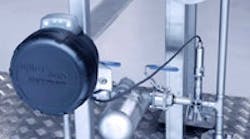ACOUSTIC TRANSMITTER
Figure 2. Plant easily added steam trap monitors to existing wireless network. Source: Emerson Process Management.
The WSTM has a built-in "zero footprint" web-based user interface that enables any user on the company Intranet to view historical trends, graphs and alarms/notifications. It also provides comprehensive reports with an energy summary that shows steam loss and its associated cost for analysis and auditing — no new software or operator training is required, says Cypress.Existing automation systems easily can integrate the WSTM data via open system interfaces. The pharmaceutical company uses OPC to bring the data into its Wonderware utilities management system; Cypress has a technology alliance with Invensys to ensure operability between its products and Wonderware software.In a second application, a pharmaceutical company in New England has installed WSTMs on its 550 steam traps.The company's traditional annual audit was taking about 140 man-hours, costing $20,000 and requiring a calendar month to complete. The pharmaceutical firm replaced all failed steam traps uncovered during the audit. However, before the next audit, around 15% of the traps would fail and start to leak. On average, it took six months before the leaks were detected, at a cost of $375,000 in lost steam.Installation of the 550 WSTMs has reduced steam leakage by 95% and cut audit labor costs by 70%. Payback was achieved in less than a year."Although we are more focused on our healthcare market at the moment, we are absolutely considering the chemical industry and it's definitely a market that we want to grow into," says David Roberts, vice president of marketing.
FOOD FOR THOUGHTA major food manufacturer based in the southeast U.S. also has benefited from wireless trap monitoring. The company had developed a preventive maintenance (PM) schedule for steam traps at a large plant that makes multiple product lines. It took a maintenance crew at least an hour to properly check each of the nearly 100 steam traps, which limited the PM to an annual exercise. To meet its demand for automatic online monitoring of steam trap performance, together with real-time alerts to minimize the need for PM and energy losses, the company installed nine Rosemount 708 wireless acoustic transmitters from
Emerson (
Figure 2).The plant already had a self-organizing wireless network for the Rosemount 3051S DP wireless flow meters it was using to monitor compressed air flow. Adding the non-intrusive wireless acoustic measurement devices was easy. "Wireless greatly reduces installation cost, and we use those savings to purchase more instrumentation to extend utility monitoring in our plant," notes the site's project engineer. The nine transmitters were put on steam lines throughout the plant and integrated into the existing Smart Wireless Gateway, which communicates to a plant host. The acoustic transmitters monitor a variety of types of steam traps and work equally well on all of them, says Emerson; one transmitter even keeps tabs on a steam-driven pump to give early indication of problems. The network was easy to expand; the new transmitters just strengthened the mesh. There's a lot of concrete between the transmitters and the gateway and high EMF, but the wireless communications are strong and reliable, adds the company."Manual monitoring of temperature did not give us enough information to conclusively target a steam trap for replacement when we saw water-hammering," explains the project engineer. "But when we installed the wireless acoustic transmitter, we could tell immediately which steam trap was stuck." It was quickly fixed, and a trend of the new trap showed normal acoustics and temperature."We found 22% of our traps needed to be replaced during our last PM check. By installing wireless acoustic transmitters, the plant will prevent steam loss with early detection of steam trap failure. Not only will this minimize energy loss, but it will free up maintenance to focus their time and attention on things that need to be fixed, to further improve our productivity," the project engineer notes.
BUILDING UPON EXPERIENCEThe AIM system from
Armstrong International provides intelligent wireless steam-trap monitoring that's designed to tackle the three constant challenges faced by plant and maintenance engineers: identifying a failure, evaluating its scope and measuring its impact. AIM (Figure 3) relies on a mix of methods, including acoustic and temperature monitoring, integrated into a smart wireless device that can deliver immediate failure notifications and pinpoint their locations.Armstrong's biggest differentiator is the knowledge it has gained in over 100 years of steam system work, says Kerry Phillips, global manager, smart services group. "We've designed, tested, constructed and maintained more steam systems than any company. This gives us an advantage to not only know how to apply proper technology for maintaining steam traps, but also the ability to provide and execute the solution when problems are identified," he notes.The chemical industry only is at the early adopters' stage when it comes to wireless steam-trap monitoring technology, says Phillips. "Based on experience, the industry's biggest concerns appear to be with reliability and cyber security. Old behavior has been to manually survey the steam traps, but as wireless technology becomes more accepted, the behaviors will change to automate steam trap testing. Wireless steam-trap monitoring is real-time, whereas manual surveys are typically done once per year. Real-time monitoring enables companies to identify the failure immediately so action can be taken. Most like to focus on the critical steam traps such as the high energy wasters and critical process."As a result, Armstrong's successes so far in the chemical industry have mainly been in high-cost application areas. "For example, a chemical company with 2,000 steam traps will typically monitor the high-steam-pressure applications as well as any steam traps that are critical to their process. Armstrong is able to identify the worst offenders, to really focus down into the areas that are affecting efficiency and costing money."This, he says, is particularly important to process and maintenance engineers who these days are under pressure to achieve more with fewer resources. "However, as energy costs rise, so does the need to stay on top of steam leaks. One steam trap failing open can lose upwards of 500,000 lb/yr of steam. Depending on your cost of steam, this could be wasting up to $8,000 per year — just for one steam trap! Typical chemical process facilities will have in excess of 1,000 steam traps, so the energy losses can add up quickly if they are not maintained regularly." Phillips cites examples at three customers to illustrate the point. The first boosted performance and profits after using the system to identify failed steam traps on high-pressure steam lines. The second had steam traps 105 ft off the ground in the middle of a pipe rack with no scaffolding support. AIM has enabled this customer to reduce downtime and reallocate valuable maintenance man-hours. The third experienced multiple steam-trap problems that caused condensate to back up into its steam turbine. Using wireless steam-trap monitoring decreased downtime and increased plant performance.





